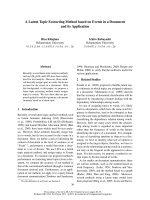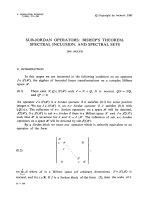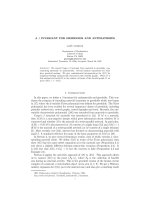Báo cáo toán học: "A short proof of a theorem of Kano and Yu on factors in regular graphs" pot
Bạn đang xem bản rút gọn của tài liệu. Xem và tải ngay bản đầy đủ của tài liệu tại đây (61.1 KB, 2 trang )
A short proof of a theorem of Kano and Yu on factors
in regular graphs
Lutz Volkmann
Lehrstuhl II f¨ur Mathematik, RWTH Aachen University, 52056 Aachen, Germany
e-mail:
Submitted: Jul 13, 2006; Accepted: Jun 1, 2007; Published: Jun 14, 2007
Mathematics Subject Classification: 05C70
Abstract
In this note we present a short proof of the following result, which is a slight
extension of a nice 2005 theorem by Kano and Yu. Let e be an edge of an r-
regular graph G. If G has a 1-factor containing e and a 1-factor avoiding e, then
G has a k-factor containing e and a k-factor avoiding e for every k ∈ {1, 2, . . . , r−1}.
Keywords: Regular graph; Regular factor; 1-factor; k-factor.
We consider finite and undirected graphs with vertex set V (G) and edge set E(G),
where multiple edges and loops are admissible. A graph is called r-regular if every vertex
has degree r. A k-factor F of a graph G is a spanning subgraph of G such that every
vertex has degree k in F . A classical theorem of Petersen [3] says:
Theorem 1 (Petersen [3] 1891) Every 2p-regular graph can be decomposed into p
disjoint 2-factors.
Theorem 2 (Katerinis [2] 1985) Let p, q, r be three odd integers such that p < q < r.
If a graph has a p-factor and an r-factor, then it has a q-factor.
Using Theorems 1 and 2, Katerinis [2] could prove the next attractive result easily.
Corollary 1 (Katerinis [2] 1985) Let G be an r-regular graph. If G has a 1-factor,
then G has a k-factor for every k ∈ {1, 2, . . . , r}.
Proofs of Theorems 1 and 2 as well as of Corollary 1 can also be found in [4]. The
next result is also a simple consequence of Theorems 1 and 2.
Theorem 3 Let e be an edge of an r-regular graph G with r ≥ 2. If G has a 1-factor
the electronic journal of combinatorics 14 (2007), #N10 1
containing e and a 1-factor avoiding e, then G has a k-factor containing e and a k-factor
avoiding e for every k ∈ {1, 2, . . . , r − 1}.
Proof. Let F and F
e
be two 1-factors of G containing e and avoiding e, respectively.
Case 1: Assume that r = 2m + 1 is odd. According to Theorem 1, the 2m-regular
graphs G − E(F ) and G − E(F
e
) can be decomposed into 2-factors. Thus there exist all
even regular factors of G containing e or avoiding e, respectively. If F
2k
is a 2k-factor of
G containing e or avoiding e, then G − E(F
2k
) is a (2m + 1 − 2k)-factor avoiding e or
containing e, respectively. Hence the statement is valid in this case.
Case 2: Assume that r = 2m is even. In view of Theorem 1, G has all regular even
factors containing e or avoiding e, respectively.
Since G has a 1-factor avoiding e, the graph G−e has a 1-factor. In addition, G−E(F )
is an (r − 1)-regular factor of G avoiding e, and so G − e has an (r − 1)-factor. Applying
Theorem 2, we deduce that G − e has all regular odd factors between 1 and r − 1, and
these are regular odd factors of G avoiding e.
If F
2k+1
is a (2k + 1)-factor of G avoiding e, then G − E(F
2k+1
) is a (2m − (2k + 1))-
factor containing e, and the proof is complete.
Corollary 2 (Kano and Yu [1] 2005) Let G be a connected r-regular graph of even
order. If for every edge e of G, G has a 1-factor containing e, then G has a k-factor
containing e and another k-factor avoiding e for all integers k with 1 ≤ k ≤ r − 1.
The following example will show that Theorem 3 is more general than Corollary 2.
Example Let G consists of 6 vertices u, v, w, x, y, z, the edges ux, vx, wy, zy, three
parallel edges between u and v, three parallel edges between w and z and two parallel
edges e and e
connecting x and y. Then G is a 4-regular graph, and G has a 1-factor con-
taining e and a 1-factor avoiding e. According to Theorem 3, G has a k-factor containing
e and a k-factor avoiding e for every k ∈ {1, 2, 3}. However, Corollary 2 by Kano and Yu
does not work, since the edges ux, vx, wy and zy are not contained in any 1-factor.
References
[1] M. Kano and Q. Yu, Pan-factorial property in regular graphs, Electron. J. Combin. 12
(2005) N23, 6 pp.
[2] P. Katerinis, Some conditions for the existence of f -factors, J. Graph Theory 9 (1985),
513-521.
[3] J. Petersen, Die Theorie der regul¨aren graphs, Acta Math. 15 (1891), 193-220.
[4] L. Volkmann, Graphen an allen Ecken und Kanten, RWTH Aachen 2006, XVI, 377 pp.
/>the electronic journal of combinatorics 14 (2007), #N10 2









